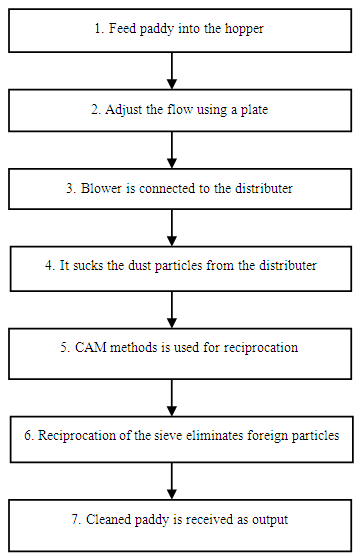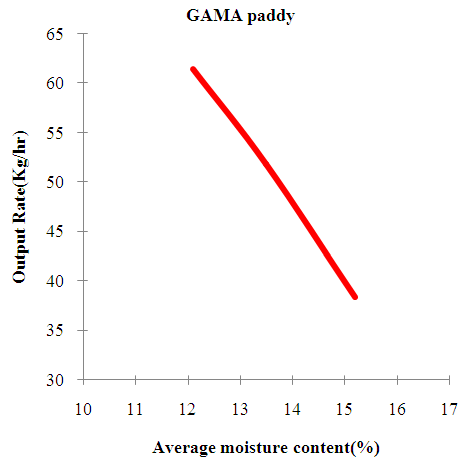-
Paper Information
- Next Paper
- Previous Paper
- Paper Submission
-
Journal Information
- About This Journal
- Editorial Board
- Current Issue
- Archive
- Author Guidelines
- Contact Us
Journal of Mechanical Engineering and Automation
p-ISSN: 2163-2405 e-ISSN: 2163-2413
2017; 7(5): 145-149
doi:10.5923/j.jmea.20170705.04

Design and Fabrication of Paddy Cleaning Machine
Ashwin Shetty, Manish Nayak, Nishith Shetty, Rhea D’mello, Vinoda Naik, Yathish K., Poornesh M.
Department of Mechanical Engineering, St Joseph Engineering College, Mangaluru, India
Correspondence to: Ashwin Shetty, Department of Mechanical Engineering, St Joseph Engineering College, Mangaluru, India.
| Email: |  |
Copyright © 2017 Scientific & Academic Publishing. All Rights Reserved.
This work is licensed under the Creative Commons Attribution International License (CC BY).
http://creativecommons.org/licenses/by/4.0/

Agriculture is the largest single industry in the world, and seed production is an important segment of this industry. Seed, as it comes from the field, contains various contaminants like weed seeds, other crop seeds, and such inert material as stems, leaves, broken seed, and dirt. Therefore, cleaning of paddy is required. Additionally, non-availability of appropriate paddy cleaning machine at reasonable price is one of the major constraints for initiating small/medium scale manufacture of paddy cleaning machine. Therefore, this working is undertaken to develop an efficient low cost paddy cleaner in view of improving the quality paddy cleaning using conventional methods. To check the performance of the paddy cleaner, a total volume of 1.15kg of uncleaned paddy consisting of 1kg of paddy, 0.05kg of dust and 0.1kg of sand was fed into the hopper. After the cleaning process, the output obtained was 1.022kg of cleaned paddy with 0.994kg of paddy, 0.021kg of dust and 0.006kg of sand. Hence the performance of this machine is very efficient where most of the paddy produced is cleaned.
Keywords: Portable paddy cleaner, Traditional winnow technique, Hand threshing, Traditional handling
Cite this paper: Ashwin Shetty, Manish Nayak, Nishith Shetty, Rhea D’mello, Vinoda Naik, Yathish K., Poornesh M., Design and Fabrication of Paddy Cleaning Machine, Journal of Mechanical Engineering and Automation, Vol. 7 No. 5, 2017, pp. 145-149. doi: 10.5923/j.jmea.20170705.04.
Article Outline
1. Introduction
- Agriculture usually plays a vital role in the economy of every nation that exists. Not only for the reason that it tends to feed the entire population of a country but also in the respect that agriculture correlates and interacts with all the related industries of that country. A country is usually considered to be a social and politically stable nation if it possesses a very stable agricultural basis.Agriculture is very important for a country's economic stability and welfare. If a country's agricultural sector is so productive that it can yield enough to feed the country's entire population, it does not have to import food from other countries. If the country's agriculture sector is so productive that it can produce enough to feed the population as well as create a surplus which can be exported, that results in great economic gain for that particular country. If, however, a country's agricultural sector is unproductive and is unable to produce enough to meet the needs of its population, it adversely affects that country's economy since then it has to import food stuff from other countries which costs a lot. As a result the goods are sold in the local markets at higher rates which the most of its population can't afford. Thus, it leads to inflation and economic instability. Therefore, it is very important for any country to have a healthy and productive agricultural sector which can provide for its population and also boost trade with other countries.India is one of the fastest growing economies of the world and is currently the focus of a great deal of international attention. It is the seventh largest country in the world in terms of its geographical size. Today it has a population of nearly 1.1 billion which makes it the second most populous nation in the world. With current population growth by 2025 India may even have caught up with China according to the UN.
2. Cleaning and Separation
- Improper cleaning usually results in grain loss and lower head rice recovery in mills. Cleaning helps to reduce bulkiness during subsequent post-harvest operation. You should remove straw pieces, unfilled grains and other foreign materials. Cleaning and winnowing can be done manually, using wind energy or with the use of machines. You can use traditional winnowers like the winnowing basket and wooden boxes with perforations. Cleaning removes unwanted materials like straws, chaff, weed seeds, soil particles and rubbish from the grain. It improves grain storability, reduces dockage during milling, gives good quality milled rice and improves the milling output. It also reduces insects, pests and disease infestation.Much seed cleaning is or should be done in the field before the crop is harvested. Good cultural practices like spray programs, crop rotation, and rouging can minimize many serious weed and contaminant problems. When a seed lot enters the processing plant for cleaning, contaminants are removed by the use of special equipment that takes advantage of differences in physical characteristics of various components in the mixture. The chief characteristics used in making separations are size, shape, density, surface texture, terminal velocity, electrical conductivity, color, and resilience. The choice of machines used and their arrangement in a processing line depends primarily on the seed being cleaned, the quantity of seeds and other contaminants in the mixture, and the purity requirements that must be met. Seed for planting is of little value unless it reaches the farmer in a viable condition, essentially free of contaminants, and at a price he can afford. The degree to which these requirements are satisfied is related to the equipment used, its arrangement in the processing plant, and the knowledge and skill of the man operating the machine.The two basic screens for cleaning round shaped seed are a round-hole top screen and a slotted bottom screen. The round-hole top screen should be selected so as to drop the round seed through the smallest hole possible, and retain anything larger. The seed drops through the top screen onto the slotted bottom screen, which takes advantage of seed shape and retains the round, good seed while dropping broken crop seed and many weed seed. The basic screens for cleaning elongated seed (oats, fescues) are a slotted top screen and a slotted bottom screen. In special separations it may be necessary to pass such seed through round-hole top screens or over some screen other than a slotted bottom screen, but generally, slotted top and bottom screens are used.Many seed shapes cannot be neatly classified as round, elongated, or lens like. For example, timothy is shaped like a football, etching like a cube, and dock or sorrel like a pyramid. Corn occurs in many irregular shapes, and Sudan grass falls in an intermediate classification between round and elongated. Consequently, when screen types are selected for specific seeds, the choice depends largely upon what must be removed from that mixture. When Sudan grass is cleaned in a multiple screen unit, the top screens usually will be a round-hole and an oblong, and the bottom screens also a round-hole and an oblong.
3. Design
- To overcome the complexity in the equipment used in the industries, the work involved reconsideration of the design. The paddy cleaner fabricated for this work includes the following calculations.
3.1. Design of Frame
- The equation used for the design of frame isApproximate weight of the machine = 120kgWeight on each leg = W = 120/4 =30 kg = 294.3NCross sectional Area of the L-section = 225 mm2Stress induced:σ =Load/Area = 294.3/225 = 1.30MpaYield stress = 250MpaDesign stress= 250/5=50Mpa.
 FOS = 5Stress induced <<< Design Stress.The design of the frame is safe.
FOS = 5Stress induced <<< Design Stress.The design of the frame is safe.3.2. Design of Shaft
- The equation used for the design of shaft is
 do = 24.70mm
do = 24.70mm3.3. Design of Bearings
- The equation used for the design of bearing is

4. Working
- The sequences of operations are as follows

5. Performance Analysis
- The Performance analysis of the machine is done considering the following parameters:• Time taken per kg of paddy • Moisture content of the paddy• Output of the machine. These parameters have been tested for 3 different varieties of paddy grown during march-may (summer crop) in Karnataka. The 3 different paddy varieties are Jaya, Aishwarya and Gama. The test results are shown below.
5.1. Jaya Paddy
- Jaya is a medium duration high yielding variety of rice. It is recommended for both crop seasons. The variety is known for its greater yield potential. The grains are long and white with good cooking quality.
 | Figure 1. Graph of Average Moisture content vs. Time taken per panicle for Jaya paddy |
 | Figure 2. Graph of Average Moisture content vs. Output Rate for Jaya paddy |
5.2. Aishwarya Paddy
- Aishwarya is a short duration high yielding variety of rice. It is recommended for three crop seasons. The variety is known for its greater yield potential. The grains are short and white.
 | Figure 3. Graph of Average Moisture content vs. Time taken per panicle for Aishwarya paddy |
 | Figure 4. Graph of Average Moisture content vs. Output Rate for Aishwarya paddy |
5.3. Gama Paddy
- From the above graphs the following inference can be drawn, Irrespective of the type of crop, the time taken for cleaning paddy increases with the increase in the moisture content of the paddy.The output rate decreases with the increase in moisture content of the paddy.
 | Figure 5. Graph of Average Moisture content vs. Time taken per panicle for Gama paddy |
 | Figure 6. Graph of Average Moisture content vs. Output Rate for Gama paddy |
 | Figure 7. Paddy cleaning machine |
6. Conclusions
- In the longer run, picking by machine mostly turns out cheaper than manual cleaning releasing funds for other quality improvements in the cellar. • A mechanical cleaner is much faster than manual cleaners. • Some say one machine does the same work as 20 harvest workers.• A mechanical cleaner is typically done in a much shorter time span than a manual cleaner. • The cleaner can also be sent out in the middle of the night to harvest. This can be a great advantage in hotter climates. • The design of this machine is such that a single operator can do the cleaning operation with ease.• The amount of paddy collected depends upon the moisture content, quality and the type of the crop.• The main concern of the grain getting damaged in the existing cleaning machines is reduced considerably by this machine. Hence grain loss is minimized.• This machine has a limited number of moving parts and hence requires less maintenance.• The filtered paddy is collected directly in a gunny bag using a hopper and hence no scattering takes place as in the case of conventional method.• The machine is cheap and easily affordable by the farmers.
 Abstract
Abstract Reference
Reference Full-Text PDF
Full-Text PDF Full-text HTML
Full-text HTML